NASA Astronaut Group 2
| Next Nine | |
|---|---|
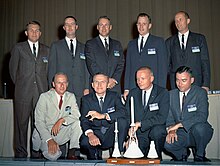 Group 2 astronauts. Back row, left to right: See, McDivitt, Lovell, White, Stafford. Front row: Conrad, Borman, Armstrong, Young. Before them are models of theMercury,Apollo,andGemini spacecraft. | |
| Year selected | 1962 |
| Number selected | 9 |
NASA Astronaut Group 2,also known as theNext Nineand theNew Nine,was the second group ofastronautsselected by theNational Aeronautics and Space Administration(NASA). Their selection was announced on September 17, 1962. The group augmented theMercury Seven.PresidentJohn F. Kennedyhad announcedProject Apollo,on May 25, 1961, with the ambitious goal of putting a man on the Moon by the end of the decade, and more astronauts were required to fly the two-manGemini spacecraftand three-manApollo spacecraftthen under development. The Mercury Seven had been selected to accomplish the simpler task of orbital flight, but the new challenges ofspace rendezvousandlunar landingled to the selection of candidates with advanced engineering degrees (for four of the nine) as well astest pilotexperience.
The nine astronauts wereNeil Armstrong,Frank Borman,Pete Conrad,Jim Lovell,James McDivitt,Elliot See,Tom Stafford,Ed White,andJohn Young.The Next Nine were the first astronaut group to include civilian test pilots: See had flown forGeneral Electric,and Armstrong had flown theX-15rocket-powered aircraftfor NASA. Six of the nine flew to the Moon (Lovell and Young twice), and Armstrong, Conrad, and Young walked on it as well. Seven of the nine were awarded theCongressional Space Medal of Honor.As of April 2024[update],the last surviving member of the group is Lovell.
Background[edit]

The launch of theSputnik 1satellite by theSoviet Unionon October 4, 1957, started aCold Wartechnological and ideological competition with the United States known as theSpace Race.The demonstration of American technological inferiority came as a profound shock to the American public.[1]In response to theSputnik crisis,a new civilian agency, theNational Aeronautics and Space Administration(NASA), wascreatedto oversee an American space program.[2]TheSpace Task Group(STG) at the NASALangley Research CenterinHampton, Virginia,created an American crewed spaceflight project calledProject Mercury.[3][4]The selection of the first astronauts, known as the "Original Seven" or "Mercury Seven",[5]was announced on April 9, 1959.[6]
By 1961, although it was yet to launch a person into space, the STG was confident that Project Mercury had overcome its initial setbacks, and that the United States had overtaken the Soviet Union as the most advanced nation in space technology. The STG began considering Mercury Mark II, a two-person successor to theMercury spacecraft.This confidence was shattered on April 12, 1961, when the Soviet Union launchedVostok 1,andcosmonautYuri Gagarinbecame the first person to orbit the Earth. In response, PresidentJohn F. Kennedyannounced a far more ambitious goal on May 25, 1961: to put a man on the Moon by the end of the decade.[7]The effort to land a man on the Moon already had a name:Project Apollo.[8]The two-person Mercury II spacecraft concept was formally announced by the STG head,Robert R. Gilruth,on December 7, 1961, and on January 3, 1962, it was officially namedProject Gemini.[9]
On April 18, 1962, NASA formally announced that it was accepting applications for a new group of astronauts who would assist the Mercury astronauts with Project Mercury, and join them in flying Project Gemini missions. It was anticipated that they might go on to command Project Apollo missions. Unlike the selection process for the Mercury Seven, which was carried out in secret, this selection was widely advertised; public announcements and the minimum standards were communicated to aircraft companies, government agencies and theSociety of Experimental Test Pilots.[10]
Selection criteria[edit]
Right now, in the beginning, we are picking experienced test pilots, not because they are fighter pilots, but because they have experience in dealing with new machines, unusual situations, being scared to death yet reacting properly. We're not saying for a minute that no one except test pilots has this experience. But this group also has the engineering background that we're looking for to get our programs started.
— Gus Grissom,February 1963[11]
The five minimum selection criteria were that an applicant:[10][12]
- was an experiencedtest pilot,with 1,500 hours test pilot flying time, who had graduated from a military test pilot school, or had test pilot experience with NASA or the aircraft industry;
- had flown high-performance jet aircraft;
- had earned a degree in engineering or the physical or biological sciences;
- was aU.S. citizen,under 35 years of age, and 6 feet 0 inches (1.83 m) or less in height; and
- was recommended by their employer.
The criteria differed from those of the Mercury Seven selection in several ways. TheGemini spacecraftwas expected to be roomier than the Mercury one, so the height requirement was relaxed slightly. This madeThomas P. Staffordeligible. A college degree was now required, but could be in the biological sciences. Civilian test pilots were now eligible, but the requirement for experience in high-performance jets favored those with recent experience, and fighter pilots over those with multi-engine experience such asScott Carpenterof the Mercury Seven. The age limit was lowered from 40 to 35 because whereas Mercury was a short-term project, Project Apollo was going to run until the end of the decade at least. The changed selection criteria meant that the selection panel could not simply select another group from the Mercury Seven finalists.[11][12][13]
At this time,Jerrie Cobb,a female award-winning pilot, was pressing for women to be allowed to become astronauts. In 1961 she was one of thirteen women known as theMercury 13who had passed the same medical evaluation tests given to the Mercury Seven astronauts as part of a USAF project that assessed the capability of women for spaceflight.[14]Although women were not prevented from applying to become NASA astronauts in 1962, the requirement for jet test pilot experience effectively excluded them.NASA AdministratorJames E. Webbmade this point in a statement to the press in spring 1962, adding: "I do not think we shall be anxious to put a woman or any other person of particular race or creed into orbit just for the purpose of putting them there."[15]
Selection process[edit]
TheU.S. Navy(USN) andU.S. Marine Corps(USMC) submitted the names of all their applicants who met the selection criteria, but theU.S. Air Force(USAF) conducted its own internal selection process, and it only submitted the names of eleven candidates.[16]The Air Force ran them through a brief training course in May 1962 on how to speak and conduct themselves during the NASA selection process. The candidates called it a "charm school".[17]GeneralCurtis LeMaytold them:
There are a lot of people who'll say you're deserting the Air Force if you're accepted into NASA. Well, I'm theChief of the Air Force,and I want you to know I want you in this program. I want you to succeed in it, and that's your Air Force mission. I can't think of anything more important.[18]
In all, 253 applications were received by the June 1, 1962, deadline.[13]Neil Armstrongsubmitted his application a week after the deadline, butWalter C. Williams,the associate director of the Space Task Group, wanted Armstrong for the space program, so he had Richard Day, who acted as secretary of the selection panel, add it to the pile of applications when it arrived.Paul Bikle,the director of the NASA'sFlight Research Center,and therefore Armstrong's Boss, declined to recommend Armstrong for astronaut selection because he had misgivings about his performance.[19]

The three-person selection panel consisted of Mercury Seven astronautsAlan ShepardandDeke Slayton,and NASA test pilotWarren J. North,although Williams sat in on some sessions.[20]They reduced the candidates to 32 finalists,[21]from whom they hoped to select between five and ten new astronauts. Nine of the USAF's eleven candidates were chosen as finalists, and one of those rejected,Joe Engle,was selected withNASA Astronaut Group 5in 1966.[16]Of the rest, thirteen were from the Navy, four were Marines, and six were civilians.[21]Four had been finalists in the Mercury Seven selection:Pete Conrad,Jim Lovell,John MitchellandRobert Solliday.[22]Lovell had not been selected for the Mercury Seven due to a highbilirubinblood count.[23]
The finalists were sent toBrooks Air Force BaseinSan Antoniofor medical examinations. The tests there were much the same as those employed to select the Mercury Seven.[24]One candidate was found to be 2 inches (5 cm) too tall.[25]Another four were eliminated on the basis of ear, nose and throat examinations.[26]The remaining 27 then went toEllington Air Force Basenear Houston, where theManned Spacecraft Center(MSC) was being established. They were individually interviewed by the selection panel.[27]
Nine candidates were selected, and their names forwarded to Gilruth for approval. Slayton informed each of them by phone on September 14.[28]The nine were Neil Armstrong,Frank Borman,Pete Conrad, Jim Lovell,James McDivitt,Elliot See,Tom Stafford,Ed White,andJohn Young.[29]They arrived in Houston on September 15. To avoid tipping off the media, all checked into theRice Hotelin Houston under the name of Max Peck, its general manager.[30]On September 17, the media crowded into the 1800-seat Cullen Auditorium at theUniversity of Houstonfor the official announcement, but it was a more low-key event than the unveiling of the Mercury Seven three years before.[31]
As with those who had been passed over in the Mercury Seven selection, most of the rejected finalists went on to have distinguished careers. Three achievedflag rank:William E. Ramseybecame avice admiralin the Navy,William H. Fitchalieutenant generalin the Marine Corps andKenneth Weir,amajor generalin the Marine Corps.[22]Four would become NASA astronauts in later selections:Alan Bean,Michael CollinsandRichard Gordonin 1963, andJack Swigertin 1966.[32]Francis G. Neubeckwas selected as an astronaut for theManned Orbiting Laboratoryprogram, but never flew in space.[33]
Demographics[edit]
Like the Mercury Seven, all of the Next Nine were male and white, and all were married, with an average of two children.[34]Unlike the Mercury Seven, not all wereProtestants;McDivitt was the firstRoman Catholicchosen as an astronaut.[35][36]Conrad, Lovell and Young were from the Navy; Borman, McDivitt, Stafford and White from the Air Force; and Armstrong and See were civilians,[29]although both had previously served in the Navy.[37][38]All were test pilots, and Borman and McDivitt were also early graduates of the USAFAerospace Research Pilot School(ARPS).[28]
Their average age at the time of selection was 33 years and one month, compared to 34 years and ten months for the Mercury Seven when they were selected in April 1959. They had an average of 2,800 flying hours each, 1,900 of them in jets. This was 700 fewer flying hours than the Mercury Seven, but 200 more hours in jets. Their average weight was slightly higher – 161.5 pounds (73.3 kg) compared to 159 pounds (72 kg).[34][39]Their mean IQ was 132 on theWechsler Adult Intelligence Scale.[40]All had earned Bachelor of Science degrees. Three had Master of Science degrees inaeronautical engineering:Borman from theCalifornia Institute of Technology,See from theUniversity of California at Los Angeles,and White fromUniversity of Michigan.[41]
Group members[edit]
| Image | Name | Born | Died | Career | Ref. |
|---|---|---|---|---|---|

|
Neil A. Armstrong | Wapakoneta, Ohio, August 5, 1930 |
August 25, 2012 | Armstrong graduated fromPurdue Universitywith a Bachelor of Science degree in aeronautical engineering in 1955. He flew 78 combat missions in theKorean Waras anaval aviator,and then became a test pilot for theNational Advisory Committee for Aeronautics(the forerunner of NASA) at theHigh-Speed Flight StationatEdwards Air Force Base,where he flew theX-15rocket-powered aircraft.He made his first spaceflight as commander ofGemini 8in March 1966, becoming NASA's first civilian astronaut to fly in space. During this mission with pilotDavid Scott,he performed the firstdockingof twospacecraft,but the mission was aborted after Armstrong was compelled to use some of his re-entry control fuel to address a dangerous roll caused by a stuckthruster.During training for his second and last spaceflight, as commander ofApollo 11,he ejected from theLunar Landing Research Vehiclemoments before a crash. In July 1969, he and hislunar module pilot,Buzz Aldrin,became the first people toland on the Moon.Armstrong was the first person to step onto its surface, and he spent two and a half hours outside the spacecraft. He earned a Master of Science degree in aerospace engineering from theUniversity of Southern Californiain 1970. He resigned from NASA in 1971, and taught aerospace engineering at theUniversity of Cincinnatiuntil 1979. He served on theApollo 13accident investigation, and on theRogers Commission,which investigated theSpace ShuttleChallengerdisaster. | [39][37] |

|
Frank F. Borman II | Gary, Indiana, March 14, 1928 |
November 7, 2023 | Borman received a Bachelor of Science degree from theUnited States Military AcademyatWest Point,in 1950. He joined the USAF and became afighter pilot.He earned a Master of Science degree in aeronautical engineering from the California Institute of Technology in 1957. He was an assistant professor ofthermodynamicsandfluid mechanicsat West Point from 1957 to 1960. He graduated from theUSAF Experimental Test Pilot Schoolwith Class 60-C, and from the ARPS with Class I. He was initially selected forGemini 5with Mercury astronautGus Grissom,but Grissom was moved to Gemini 3, with Young as his pilot. Borman commanded theGemini 7mission in December 1965. On this mission he and Lovell spent two weeks in space, during which they performed the firstspace rendezvouswithGemini 6A.After the January 1967Apollo 1fire in which astronauts Grissom, White, andRoger Chaffeedied, he was the astronaut representative on the accident investigation board. In December 1968, he commandedApollo 8,the first crewed circumlunar mission. He retired from NASA and the USAF in 1970 and joinedEastern Airlines,eventually becoming itsChairman of the Boardin December 1976. | [39][42][43][44][45] |
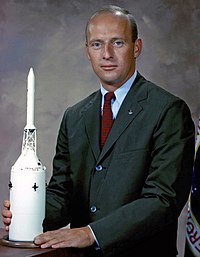
|
Charles (Pete) Conrad Jr. | Philadelphia,Pennsylvania, June 2, 1930 |
July 8, 1999 | Conrad graduated fromPrinceton Universityin 1953 with a Bachelor of Science degree in aeronautical engineering. He joined the Navy and became a naval aviator. In 1958, he graduated from theUnited States Naval Test Pilot SchoolatNaval Air Station Patuxent River,Patuxent, Marylandas part of Class 20. He set an eight-day space endurance record along with his command pilot, Mercury astronautGordon Cooper,on his first spaceflight, theGemini 5mission in August 1965. The following year he commanded theGemini 11mission, on which he and pilot Dick Gordon set an altitude record of 850 miles (1,370 km). He became the third person to walk on the Moon as commander ofApollo 12in 1969 after landing the lunar moduleIntrepidin theOcean of Storms.He and pilot Alan Bean made two moonwalks, recovering components from theSurveyor 3probe, which had landed there two years before. In 1973 he commandedSkylab 2,the first crewed Skylab mission, and spent 28 more days in space. On this mission, he and his crewmates repaired significant launch damage to theSkylabspace station.He retired from NASA and the Navy in 1973. | [39][42][46] |
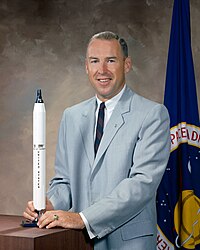
|
James A. Lovell Jr. | Cleveland,Ohio, March 25, 1928 |
Lovell graduated with a Bachelor of Science degree from theUnited States Naval AcademyatAnnapolis, Maryland,with the Class of 1952, and became a naval aviator. In 1958, he graduated from theUnited States Naval Test Pilot Schoolwith Class 20. He flew as the pilot of theGemini 7mission in December 1965 during which he and Borman spent two weeks in space and conducted the first space rendezvous withGemini 6A.In November 1966 he commanded theGemini 12mission withBuzz Aldrinas his pilot. He was thecommand module piloton theApollo 8mission in December 1968, during which he, Borman andBill Andersconducted the first crewed circumlunar mission. In April 1970, he became the first person to fly in space four times, and the first to travel to the Moon twice, when he commanded the ill-fatedApollo 13mission. He resigned from NASA and the Navy on March 1, 1973. | [39][47] | |
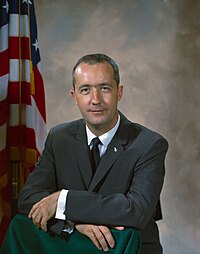
|
James A. McDivitt | Chicago, Illinois, June 10, 1929 |
Tucson, Arizona, October 13, 2022 |
McDivitt joined the USAF in 1951 and flew 145 combat missions in the Korean War. He received a Bachelor of Science degree in aeronautical engineering from the University of Michigan, graduating first in the class in 1959. That year he also graduated from theUSAF Experimental Test Pilot Schoolwith Class 59-C, and he graduated from the ARPS with Class I in 1960. He commanded theGemini 4mission, during which White performed the first U.S.spacewalk.He was the first astronaut to command his first space mission. In March 1969, he commanded theApollo 9flight, which was the first crewed flight test of the Lunar Module and the complete set of Apollo flight hardware. He later became Manager of Lunar Landing Operations and was the Apollo Spacecraft Program Manager from 1969 to 1972. In February 1972, he was promoted to the rank ofbrigadier general,becoming the first astronaut to reach that rank. He retired from NASA and the USAF later that year to pursue a career in the aviation industry, and became a senior vice president atRockwell International. | [39][48][35][36] |
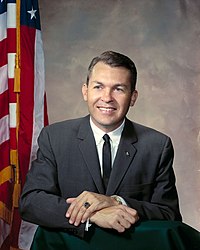
|
Elliot M. See, Jr. | Dallas,Texas, July 23, 1927 |
February 28, 1966 | See graduated from theUnited States Merchant Marine Academyin 1949 with a Bachelor of Science degree inmarine engineeringand a commission in theUnited States Naval Reserve.That year he joinedGeneral Electric.He served on active duty with the U.S. Navy from 1953 to 1956, then rejoined General Electric, becoming a test pilot. He earned a Master of Science degree in aeronautical engineering from the University of California in Los Angeles in 1962. See was chosen as the command pilot ofGemini 9,but died in aT-38 plane crashless than four months before launch. | [39][38] |

|
Thomas P. Stafford | Weatherford, Oklahoma, September 17, 1930 |
March 18, 2024 | Stafford graduated with a Bachelor of Science degree from theUnited States Naval AcademyatAnnapolis, Marylandwith the Class of 1952 and joined the USAF. He graduated from theUSAF Experimental Test Pilot Schoolwith Class 58-C. He made his first spaceflight in December 1965 as the pilot ofGemini 6A,which made the first space rendezvous, with Gemini 7. In June of the following year he commandedGemini 9A.In 1969, Stafford was the commander ofApollo 10,the second crewed mission to orbit the Moon and the first to fly a Lunar Module in lunar orbit, descending to an altitude of 9 miles (14 km) above its surface. On the return to Earth, the Apollo 10 spacecraft achieved a speed of 24,791 miles per hour (39,897 km/h), setting the record for the fastest speed achieved by human beings. In 1975, Stafford was the commander of theApollo-Soyuz Test Projectflight, the first joint U.S.-Soviet space mission. He was a brigadier general at the time of the mission, becoming the first general officer to fly in space, as well as the first member of his Naval Academy class to pin on the first, second, and third stars of a general officer. He retired from the USAF in 1979. | [39][49][50][51] |

|
Edward H. White II | San Antonio,Texas, November 14, 1930 |
Cape Canaveral, Florida, January 27, 1967 |
White received a Bachelor of Science degree from theUnited States Military AcademyatWest Point,graduating with the Class of 1952. He joined the USAF and became afighter pilot.He earned a Master of Science degree in aeronautical engineering from the University of Michigan in 1959. He graduated from theUSAF Experimental Test Pilot Schoolwith Class 59-C. In June 1965, he flew onGemini 4as its pilot, during which he conducted the first Americanspacewalk.He was selected as the Senior Pilot ofApollo 1,the inaugural flight of the Apollo spacecraft. White was killed in the fire on the launch pad test in January 1967, a month before the scheduled liftoff. | [39][52] |
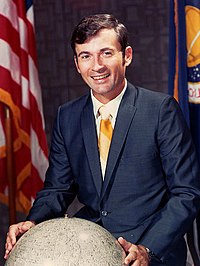
|
John W. Young | San Francisco, California, September 24, 1930 |
January 5, 2018 | Young graduated fromGeorgia Institute of Technologywith a Bachelor of Science degree in aeronautical engineering in 1952 and joined the Navy. He set world time-to-climb records for 3,000 metres (9,800 ft) and 25,000 metres (82,000 ft). His first space mission was as pilot ofGemini 3,the first crewed Gemini mission, in March 1965. He went on to commandGemini 10in July 1966. In May 1969, he was Command Module pilot ofApollo 10,the "dress rehearsal" for theApollo 11Moon landing. On the way back to Earth, the Apollo 10 crew reached a speed of 24,791 miles per hour (39,897 km/h), the highest speed attained by a crewed vehicle. He returned to the Moon in April 1972 as commander ofApollo 16,the fifth crewed lunar landing, becoming the ninth person to walk on the Moon and the second to fly to it twice. He served asChief of the Astronaut Officefrom 1974 to 1987. In April 1981, he commanded theSTS-1mission, the maiden flight of theSpace ShuttleColumbia.When he commandedSTS-9,the firstSpacelabmission, in November 1983, he became the first person to travel into space six times. | [39][49][53] |
Assimilation[edit]
The new astronauts became known as the Next Nine,[54]or the New Nine.[55]They moved to the Houston area in October 1962. Most of them bought lots and built houses inNassau Bay,a new development to the east of the MSC.[56]Conrad and Lovell built houses inTimber Cove,south of the MSC.[57]Developers in Timber Cove and Nassau Bay offered astronauts mortgages with small down payments and low interest rates.[58]The MSC complex was not yet complete, so NASA temporarily leased office space in Houston.[59]Slayton's wife Marge and Borman's wife Susan organized an Astronauts' Wives Club along the lines of the Officers' Wives Clubs that were a feature of military bases. As Slayton was in charge of astronaut activities, Marge was considered to be the equivalent of thecommanding officer's wife.[56][60]The nine were honored guests at Houston society parties, such as those thrown by socialiteJoanne Herring,and their wives received $1,000Neiman Marcusgift vouchers (equivalent to $10,000 in 2023) from an anonymous source.[61]
A lawyer, Henry Batten, agreed to negotiate a deal withField Enterprisesfor their personal stories, along the lines of theLifemagazine deal enjoyed by the Mercury Seven, for no fee. As with theLifedeal, there was some disquiet about the propriety of astronauts cashing in on government-created fame, but Mercury Seven astronautJohn Glennintervened, and personally raised the matter with Kennedy, who approved the deal.[56]The deals with Field andTime-Life(which ownedLifemagazine) earned each of the Next Nine astronauts $16,250 (equivalent to $164,000 in 2023) per annum over the next four years, and provided them with $100,000life insurancepolicies (equivalent to $1,007,000 in 2023). Due to the dangerous nature of an astronaut's job, insurance companies would have charged them unaffordably high premiums.[62]
Training[edit]

Astronaut training was supervised by Raymond Zedehar, who reported to Warren North, the Director of Flight Crew Operations at the MSC. Initially, each of the astronauts was given four months' of classroom instruction on subjects such asspacecraft propulsion,orbital mechanics,astronomy,computing,andspace medicine.Classes were for six hours a day, two days a week. There was also familiarization with the Gemini spacecraft,Titan IIandAtlasboosters, and theAgena target vehicle.After classroom training was completed, there was a series of seminars on space science. The astronaut's lack of scientific training was recognized, but it was hoped that this would bring their knowledge up to a level where they could communicate with scientists. The first was delivered byHomer E. Newell Jr.,NASA's Director of Space Sciences. Subsequent seminars covered topics such as the USAF's X-15 andX-20 Dyna-Soarprograms, and the development ofnuclear rocket engines.GeologistEugene Shoemakerdeveloped a training plan to teach the astronauts the fundamentals of selenology, thegeology of the Moon.In January 1963 they went toFlagstaff, Arizona,where they studied theMeteor Craterandlavaflows, and observed the Moon through the telescope at theLowell Observatory.[63][64]
In Zero-G training atWright-Patterson Air Force Basein Ohio on May 20, 1963, each the Next Nine astronauts flew two flights in areduced-gravity aircraft,a modifiedKC-135 Stratotankeraircraft. Each flight flew 20parabolasthat gave them between 20 and 30 seconds of weightlessness. Jungle survival training was conducted for all sixteen Mercury Seven and Next Nine astronauts at the USAF Tropic Survival School atAlbrook Air Force Stationin Panama in June. This was the first time that the two groups had trained together. This was followed in August by desert survival training at Stead Air Force Base inNevada,and field exercises atCarson Sink.Each astronaut had to survive on four liters (ten U.S. pints) of water and the food in their spacecraft survival packs. In September, all sixteen were given instruction in parachute landings on land and water, but only the Next Nine attended the second phase of the program, water survival training on theDilbert Dunkerat the USN school at theNaval Air Station Pensacolain Florida and onGalveston Bay.[65]
Following the precedent set by the Mercury Seven, each of the Next Nine was assigned a special area in which to develop expertise that could be shared with the others, and to provide astronaut input to designers and engineers.[56]Armstrong was responsible for trainers and simulators; Borman for boosters, with special responsibility for abort systems; Conrad for cockpit layout, pilot controls and systems integration; Lovell for recovery systems, including the parachutes,paragliderandlunar module;McDivitt for guidance and navigation systems; See for electrical systems and coordination of mission planning; Stafford for communications systems, mission control and the ground support network; White for flight control systems, and Young for environmental control systems, survival gear, personal equipment andspace suits.[66][67]
Legacy[edit]

Collins wrote that in his opinion "this group of nine was the best NASA ever picked, better than the seven that preceded it, or the fourteen, five, nineteen, eleven and seven that followed."[68]Slayton felt so too, describing them as "probably the best all-round group ever put together."[69]Looking over the tentative schedule of Apollo missions, Slayton calculated that up to 14 three-person crews might be required, but the 16 astronauts on hand could fill just five. Though he considered the schedule to be optimistic, he did not want a shortage of astronauts to be the reason the schedule could not be met, and he therefore proposed another round of recruiting.[70]On June 5, 1963, NASA announced that it was seeking another ten to fifteen new astronauts.[71]
The Next Nine went on to illustrious careers as astronauts. Apart from See and White, who were killed in a T-38 crash and in the Apollo fire, respectively, all went on to command Gemini and Apollo missions. Six of the nine flew to the Moon (Lovell and Young twice), and Armstrong, Conrad and Young walked on it as well.[72]Seven of the nine received theCongressional Space Medal of Honorfor their service, valor, and sacrifice:[73]
- Armstrong, for commandingApollo 11,the first lunar landing;[74]
- Borman, for commandingApollo 8,the first crewed mission to the Moon;[74]
- Conrad, for commandingSkylab 2,and saving the damaged station;[75]
- Lovell, for commanding the ill-fatedApollo 13;[76]
- Stafford, for commanding the international Cold WarApollo-Soyuz Test Project;[77]
- White, posthumously, killed in theApollo 1fire;[78]and
- Young, for commanding the first Space Shuttle mission,STS-1,in theColumbia.[79]
Citations[edit]
- ^Swenson, Grimwood & Alexander 1966,pp. 28–29, 37.
- ^Swenson, Grimwood & Alexander 1966,p. 82.
- ^Burgess 2011,pp. 29–30.
- ^Swenson, Grimwood & Alexander 1966,pp. 131–132.
- ^"All 'Original Seven' American astronauts now dead".phys.org.December 8, 2016.RetrievedMay 5,2019.
- ^Deiss, Heather (June 5, 2013)."Mercury – April 1959".NASA.RetrievedMarch 28,2019.
- ^Burgess 2013,pp. 3–4.
- ^Brooks, Grimwood & Swenson 1979,p. 15.
- ^Hacker & Grimwood 2010,pp. 1–5.
- ^abBurgess 2013,pp. 5–6.
- ^abGrissom, Gus(February 1963)."The MATS Flyer Interviews Major Gus Grissom".The MATS Flyer(Interview). Interviewed by John P. Richmond, Jr. Military Air Transport Service, United States Air Force. pp. 4–7.RetrievedJune 28,2020.
- ^abAtkinson & Shafritz 1985,p. 10.
- ^abSlayton & Cassutt 1994,pp. 118–119.
- ^Weitekamp, Margaret A. (January 28, 2010)."Lovelace's woman in space program".NASA.RetrievedMay 6,2019.
- ^"More Astronauts to be Picked Soon"(PDF).NASA Roundup.Vol. 1, no. 12. April 4, 1962.RetrievedMay 6,2019.
- ^abBurgess 2013,pp. 10–11.
- ^Stafford & Cassutt 2002,p. 36.
- ^Borman & Serling 1988,pp. 87–88.
- ^Hansen 2012,pp. 195–197.
- ^Burgess 2013,p. 7.
- ^abBurgess 2013,pp. 32–33.
- ^abBurgess 2013,p. 343.
- ^Kluger & Lovell 1995,pp. 180–183.
- ^Burgess 2013,pp. 37–40.
- ^Burgess 2013,p. 43.
- ^Burgess 2013,pp. 47–48.
- ^Burgess 2013,pp. 50–52.
- ^abSlayton & Cassutt 1994,p. 120.
- ^abBurgess 2013,pp. 64–67.
- ^Burgess 2013,pp. 62–63.
- ^Burgess 2013,pp. 64–66.
- ^Burgess 2013,p. 67.
- ^Burgess 2013,pp. 117–120.
- ^ab"Space: Nine More Astronauts".Time.September 28, 1962.RetrievedMay 6,2019.
- ^abFrench & Burgess 2007,p. 26.
- ^abStevens, Clifford (March 13, 1969)."Profile of an Astronaut: The Jim McDivitt A Pastor Knows".The Advocate.Vol. 18, no. 11.RetrievedAugust 23,2021.
- ^abBurgess 2013,pp. 145–147.
- ^abBurgess 2013,pp. 154–155.
- ^abcdefghij"MSC Names Nine New Pilot Trainees"(PDF).NASA Roundup.Vol. 1, no. 24. September 19, 1962. pp. 1, 4–5.RetrievedMay 7,2019.
- ^Collins 2001,p. 42.
- ^Burgess 2013,p. 54.
- ^abBurgess 2013,pp. 147–149.
- ^Borman & Serling 1988,p. 102.
- ^Slayton & Cassutt 1994,pp. 136–138.
- ^"NASA astronaut Frank Borman who commanded Apollo 8 to the moon dies".NPR.RetrievedNovember 9,2023.
- ^Conrad & Klausner 2005,pp. 113–118.
- ^Burgess 2013,pp. 150–152.
- ^Burgess 2013,pp. 152–153.
- ^abHadhazy, Adam (August 10, 2015)."How fast could humans travel safely through space?".BBC.RetrievedMay 7,2019.
- ^Burgess 2013,pp. 155–156.
- ^"Thomas P. Stafford:: Notable Graduates:: USNA".United States Naval Academy.RetrievedAugust 23,2021.
- ^Burgess 2013,pp. 156–158.
- ^Burgess 2013,pp. 158–159.
- ^Wolfe 1979,pp. 392–393.
- ^Koppel 2013,p. x.
- ^abcdSlayton & Cassutt 1994,p. 123.
- ^Koppel 2013,pp. 103–104.
- ^Wolfe 1979,p. 396.
- ^Burgess 2013,p. 163.
- ^Wolfe 1979,pp. 396–398.
- ^Koppel 2013,pp. 110–111.
- ^Burgess 2013,p. 164.
- ^"Training of Astronaut candidates"(PDF)(Press release). NASA. January 26, 1963. 63-10.RetrievedSeptember 17,2021.
- ^Burgess 2013,pp. 165–169.
- ^Burgess 2013,pp. 170–174.
- ^"Training of Astronaut candidates"(PDF)(Press release). NASA. January 26, 1963. 63-13.RetrievedSeptember 17,2021.
- ^Burgess 2013,pp. 166–167.
- ^Collins 2001,p. 32.
- ^Slayton & Cassutt 1994,p. 119.
- ^Slayton & Cassutt 1994,p. 132.
- ^Morse & Bays 1973,p. 61.
- ^"Apollo Astronauts".National Air and Space Museum.RetrievedMay 8,2019.
- ^"Congressional Space Medal of Honor".NASA. April 28, 2006.RetrievedMay 5,2019.
- ^ab"Kennedy Space Center, Florida Remarks at the Congressional Space Medal of Honor Awards Ceremony".The American Presidency Project.RetrievedMay 8,2019.
- ^"NASA Honors Apollo 12 Commander Charles Conrad".NASA.RetrievedMay 8,2019.
- ^"Remarks on Presenting the Congressional Space Medal of Honor to James A. Lovell, Jr., and an Exchange With Reporters".The American Presidency Project.RetrievedMay 8,2019.
- ^Pearlman, Robert Z. (June 27, 2005)."Moon Rock to be Awarded to Apollo-Soyuz Astronaut Thomas Stafford".Space.RetrievedMay 7,2017.
- ^"William J. Clinton: Remarks on Presenting the Congressional Space Medal of Honor Posthumously to Roger B. Chaffee and Edward H. White II".The American Presidency Project.RetrievedMay 7,2019.
- ^"Remarks at a White House Luncheon Honoring the Astronauts of the Space Shuttle Columbia".The American Presidency Project.RetrievedMay 8,2019.
General references[edit]
- Atkinson, Joseph D. & Shafritz, Jay M. (1985).The Real Stuff: A History of NASA's Astronaut Recruitment Program.Praeger special studies. New York: Praeger.ISBN978-0-03-005187-6.OCLC12052375.
- Borman, Frank&Serling, Robert J.(1988).Countdown: An Autobiography.New York: Silver Arrow.ISBN0-688-07929-6.OCLC17983615.
- Brooks, Courtney G.; Grimwood, James M. & Swenson, Loyd S. Jr. (1979).Chariots for Apollo: A History of Manned Lunar Spacecraft.NASA History Series. Washington, D.C.: Scientific and Technical Information Branch, NASA.ISBN978-0-486-46756-6.LCCN79001042.OCLC4664449.SP-4205.
- Burgess, Colin(2011).Selecting the Mercury Seven: The Search for America's First Astronauts.Springer-Praxis books in space exploration. New York; London: Springer.ISBN978-1-4419-8405-0.OCLC747105631.
- Burgess, Colin(2013).Moon Bound: Choosing and Preparing NASA's Lunar Astronauts.Springer-Praxis books in space exploration. New York; London: Springer.ISBN978-1-4614-3854-0.OCLC905162781.
- Collins, Michael(2001) [1974].Carrying the Fire: An Astronaut's Journeys.New York: Cooper Square Press.ISBN978-0-8154-1028-7.OCLC45755963.
- Conrad, Nancy & Klausner, Howard (May 2005).Rocketman: Astronaut Pete Conrad's Incredible Ride to the Moon and Beyond.New York: New American Library.ISBN0-451-21509-5.OCLC57311427.
- French, Francis&Burgess, Colin(2007).In the Shadow of the Moon: A Challenging Journey to Tranquility.Lincoln, Nebraska: University of Nebraska Press.ISBN978-0-8032-1128-5.OCLC804741762.
- Hacker, Barton C. & Grimwood, James M. (2010) [1977].On the Shoulders of Titans: A History of Project Gemini(PDF).NASA History Series. Washington, D.C.: NASA History Division, Office of Policy and Plans.ISBN978-0-16-067157-9.OCLC945144787.NASA SP-4203.
- Hansen, James R. (2012).First Man: The Life of Neil A. Armstrong.New York: Simon & Schuster.ISBN978-1-4767-2781-3.OCLC1029741947.
- Kluger, Jeffrey&Lovell, Jim(July 1995).Lost Moon: The Perilous Voyage of Apollo 13.New York: Pocket Books.ISBN0-671-53464-5.OCLC1053909345.
- Koppel, Lily(2013).The Astronaut Wives Club.New York: Grand Central Publishing.ISBN978-1-4555-0325-4.OCLC816563627.
- Morse, Mary Louise & Bays, Jean Kernahan (1973)."The Apollo Spacecraft – A Chronology, Volume II: November 8, 1962 – September 30, 1964"(PDF).The NASA Historical Series. Washington, D.C.: NASA. NASA SP-4009.
- Slayton, Donald K. "Deke"&Cassutt, Michael(1994).Deke! U.S. Manned Space: From Mercury to the Shuttle.New York: Forge.ISBN978-0-312-85503-1.OCLC937566894.
- Stafford, Thomas P.&Cassutt, Michael(2002).We Have Capture.Washington, D.C.: Smithsonian Institution Press.ISBN978-1-58834-070-2.OCLC829407543.
- Swenson, Loyd S. Jr.; Grimwood, James M. & Alexander, Charles C. (1966).This New Ocean: A History of Project Mercury(PDF).The NASA History Series. Washington, DC: National Aeronautics and Space Administration.OCLC569889.NASA SP-4201.
- Wolfe, Tom(1979).The Right Stuff.New York: Farrar, Straus and Giroux.ISBN978-0-553-27556-8.OCLC849889526.
External links[edit]
 Media related toNASA Astronaut Group 2at Wikimedia Commons
Media related toNASA Astronaut Group 2at Wikimedia Commons
